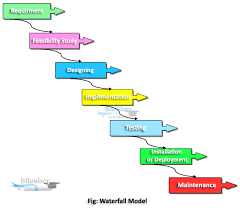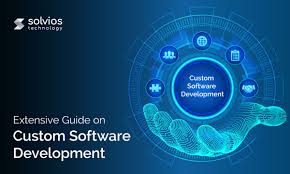Exploring the Waterfall Model in Software Development: A Traditional Approach
The Waterfall Model in Software Development
The waterfall model is a traditional approach to software development that follows a linear and sequential process. In this model, each phase must be completed before the next phase can begin, resembling a waterfall cascading down in one direction.
Phases of the Waterfall Model:
- Requirements Gathering: The initial phase where project requirements are gathered and documented.
- System Design: Based on the requirements, the system architecture and design are created.
- Implementation: The actual coding and programming of the software take place in this phase.
- Testing: Once the implementation is done, testing is performed to ensure the software meets the specified requirements.
- Deployment: The final product is deployed to users after successful testing and approval.
- Maintenance: Post-deployment phase where any issues or enhancements are addressed as needed.
Advantages of the Waterfall Model:
- Predictable and easy to understand process flow.
- Clear documentation at each stage facilitates better understanding and maintenance.
- Suitable for projects with well-defined requirements and stable technology.
Disadvantages of the Waterfall Model:
- Rigid structure makes it challenging to accommodate changes once a phase is completed.
- No working software until late in the development cycle, potentially leading to surprises or mismatches with user expectations.
- Risk of customer dissatisfaction due to limited opportunities for feedback during development.
In conclusion, while the waterfall model has its strengths in providing a structured approach to software development, its rigidity can be a limitation in today’s dynamic and fast-paced environment. It is essential for organizations to evaluate their project requirements carefully before choosing this model for their software development endeavors.
8 Essential Tips for Successful Waterfall Software Development
- Clearly define requirements at the beginning of the project.
- Create a detailed project plan outlining all stages of development.
- Stick to the planned schedule to ensure timely delivery.
- Implement thorough testing at each stage to catch issues early.
- Avoid making major changes once development has begun.
- Ensure clear communication among team members and stakeholders throughout the process.
- Document each phase of development for future reference and maintenance purposes.
- Conduct a comprehensive review after project completion to identify areas for improvement in future projects.
Clearly define requirements at the beginning of the project.
In the context of waterfall software development, it is crucial to clearly define requirements at the beginning of the project. By establishing a comprehensive understanding of what needs to be achieved upfront, teams can effectively plan and execute each phase in a sequential manner. Clear requirements help mitigate risks of scope creep and ensure that the final product aligns with stakeholders’ expectations. This proactive approach sets a solid foundation for success by providing a roadmap that guides development efforts towards meeting project goals efficiently and effectively.
Create a detailed project plan outlining all stages of development.
Creating a detailed project plan outlining all stages of development is crucial in the waterfall software development model. By clearly defining each phase, from requirements gathering to deployment, teams can establish a roadmap for the project, ensuring that tasks are completed in a sequential and orderly manner. This comprehensive plan helps in setting expectations, managing resources effectively, and maintaining clarity throughout the development process. Additionally, having a well-defined project plan allows stakeholders to track progress, identify potential bottlenecks early on, and make informed decisions to keep the project on track towards successful completion.
Stick to the planned schedule to ensure timely delivery.
Adhering to the planned schedule is crucial in waterfall software development to ensure timely delivery of the project. By sticking to the defined timeline for each phase, teams can maintain momentum and progress smoothly from one stage to the next. This discipline helps in meeting deadlines, managing resources efficiently, and ultimately delivering the final product on time. Deviating from the schedule can lead to delays, cost overruns, and potential disruptions in the project timeline. Therefore, staying committed to the planned schedule is key to successful execution and timely completion of software development projects following the waterfall model.
Implement thorough testing at each stage to catch issues early.
Implementing thorough testing at each stage of the waterfall software development process is crucial to catch issues early and ensure a high-quality end product. By conducting comprehensive testing throughout each phase, potential problems can be identified and rectified promptly, reducing the risk of costly rework or delays later in the project. This proactive approach not only helps maintain the project timeline but also enhances the overall reliability and performance of the software being developed.
Avoid making major changes once development has begun.
It is crucial to adhere to the advice of avoiding major changes once development has commenced in a waterfall software development project. The waterfall model’s sequential nature means that each phase builds upon the previous one, making it challenging to accommodate significant alterations once a stage is completed. Introducing major changes mid-development can disrupt the entire process, leading to delays, increased costs, and potential rework. By carefully defining and finalizing requirements upfront, stakeholders can minimize the need for modifications later on, ensuring a smoother and more efficient software development cycle.
Ensure clear communication among team members and stakeholders throughout the process.
Clear communication among team members and stakeholders is crucial in ensuring the success of a waterfall software development project. From the initial requirements gathering stage to the final deployment and maintenance phases, maintaining open and transparent communication channels helps in aligning everyone’s expectations, addressing any issues promptly, and fostering collaboration. Regular updates, progress reports, and feedback sessions enable team members to stay on the same page, identify potential roadblocks early on, and make informed decisions to deliver a high-quality product that meets stakeholders’ needs effectively.
Document each phase of development for future reference and maintenance purposes.
It is crucial to document each phase of development in the waterfall model for future reference and maintenance purposes. Comprehensive documentation provides a clear record of the project’s progress, decisions made, and the rationale behind them. This documentation serves as a valuable resource for understanding the software system, making updates or enhancements, and troubleshooting issues that may arise during maintenance. By documenting each phase meticulously, developers and stakeholders can ensure continuity and efficiency in managing the software throughout its lifecycle.
Conduct a comprehensive review after project completion to identify areas for improvement in future projects.
Conducting a comprehensive review after project completion in the waterfall software development process is crucial for identifying areas that can be improved in future projects. By analyzing the entire project lifecycle, including requirements gathering, design, implementation, testing, deployment, and maintenance phases, teams can pinpoint strengths and weaknesses in their processes. This review enables organizations to learn from past experiences, refine their methodologies, and enhance efficiency and effectiveness in subsequent projects.












